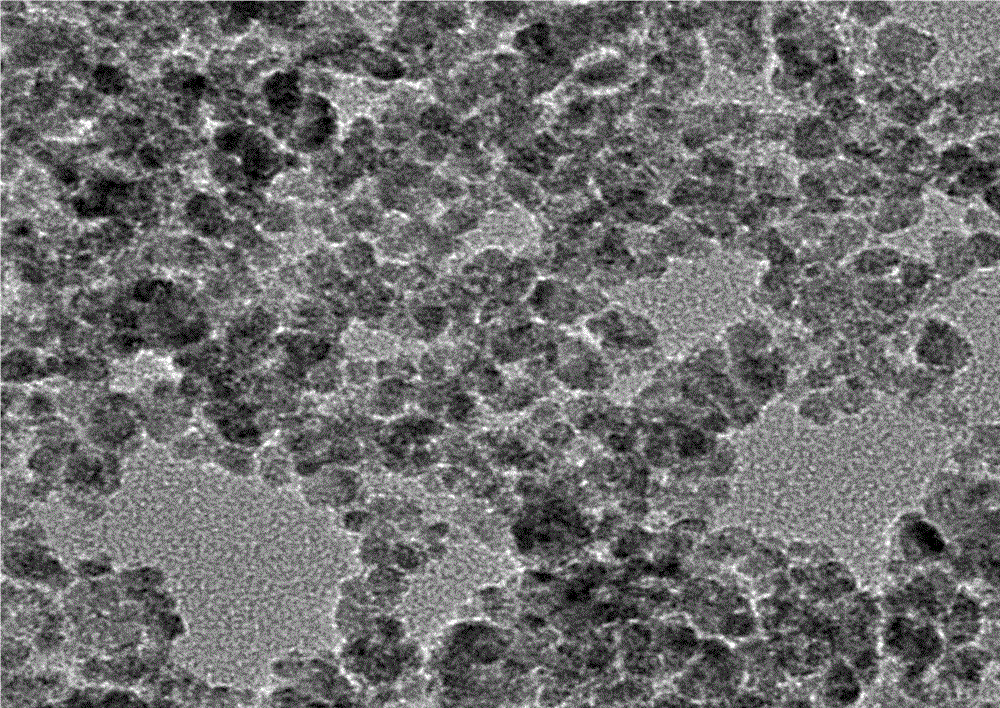Method for preparing nanoscale graphene doped tin antimony oxide thermal insulation dispersion liquid
A technology of tin antimony oxide and graphene, applied in chemical instruments and methods, antimony oxide/antimony hydroxide/antimony oxyacid, nanotechnology, etc., can solve problems such as affecting the quality of coatings
- Summary
- Abstract
- Description
- Claims
- Application Information
AI Technical Summary
Problems solved by technology
Method used
Image
Examples
Embodiment 1
[0020] Example 1: Add 23.45 grams of tin tetrachloride and 4.56 grams of antimony trichloride according to the molar ratio of Sn and Sb 90:20, add 28.01 grams of absolute ethanol and 1.4 grams of 6mol / L HNO 3 And keep stirring until all dissolved; add 32.15 grams of EDTA and 21.14 grams of CA to the solution, then use 3mol / L ammonia solution to adjust the pH value of the solution to 7; heat the solution at 60°C to evaporate excess water and ethanol until a viscous sol is formed. After fully stirring the sol dispersion system, coat it on a special metal plate, so that the coating thickness is below 3mm, and then vacuum-dry the metal plate at 100°C; remove the dry gel from the metal plate, and place it in Ignite in a combustion furnace at 600°C, and after the reaction is completed, fluffy light blue ATO powder can be obtained; ATO powder and nano-scale graphene are dispersed in NMP by ultrasonic and ball milling methods to make a solid content It is an NMP dispersion of 10% ATO...
Embodiment 2
[0021] Example 2: Add 23.45 grams of tin tetrachloride and 4.56 grams of antimony trichloride according to the molar ratio of Sn and Sb 90:20, add 140.04 grams of absolute ethanol and 2.8 grams of 6mol / L HNO 3 And keep stirring until all dissolved; add 48.22 grams of EDTA and 21.14 grams of CA to the solution, then use 3mol / L ammonia solution to adjust the pH value of the solution to 7.5; heat the solution at 65°C to evaporate excess water and ethanol until a viscous sol is formed. After fully stirring the sol dispersion system, coat it on a special metal plate, so that the coating thickness is below 3mm, and then vacuum-dry the metal plate at 100°C; remove the dry gel from the metal plate, and place it in Ignite in a combustion furnace at 650°C, and after the reaction is completed, fluffy light blue ATO powder can be obtained; ATO powder and nano-scale graphene are dispersed in NMP by ultrasonic and ball milling methods respectively to make solid content It is an NMP dispers...
Embodiment 3
[0022] Example 3: Add 23.45 grams of tin tetrachloride and 4.56 grams of antimony trichloride according to the molar ratio of Sn and Sb 90:20, add 280.07 grams of absolute ethanol and 5.6 grams of 6mol / L HNO 3 And keep stirring until all dissolved; add 64.29 grams of EDTA and 21.14 grams of CA to the solution, then use 3mol / L ammonia solution to adjust the pH value of the solution to 8; heat the solution at 70°C to evaporate excess water and ethanol until a viscous sol is formed. After fully stirring the sol dispersion system, coat it on a special metal plate, so that the coating thickness is below 3mm, and then vacuum-dry the metal plate at 100°C; remove the dry gel from the metal plate, and place it in Ignite in a combustion furnace at 700°C, and after the reaction is completed, a fluffy light blue ATO powder can be obtained; the ATO powder and nano-scale graphene are dispersed in NMP by ultrasonic and ball milling methods to make a solid content It is an NMP dispersion liq...
PUM
 Login to View More
Login to View More Abstract
Description
Claims
Application Information
 Login to View More
Login to View More - R&D Engineer
- R&D Manager
- IP Professional
- Industry Leading Data Capabilities
- Powerful AI technology
- Patent DNA Extraction
Browse by: Latest US Patents, China's latest patents, Technical Efficacy Thesaurus, Application Domain, Technology Topic, Popular Technical Reports.
© 2024 PatSnap. All rights reserved.Legal|Privacy policy|Modern Slavery Act Transparency Statement|Sitemap|About US| Contact US: help@patsnap.com








